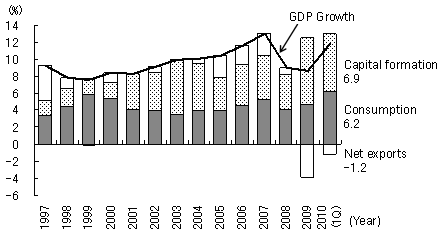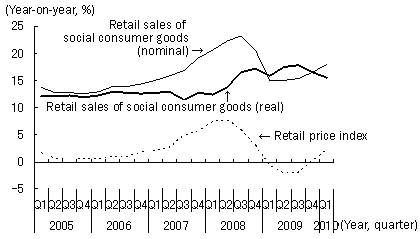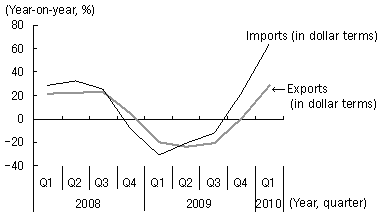The Chinese economy decelerated sharply following the collapse of Lehman Brothers in September 2008, with exports declining significantly. However, it has since recovered ahead of advanced economies, thanks to the successful outcomes of the expansionary fiscal and monetary policies that were promptly taken by the government. China's GDP growth turned upward after bottoming out at 6.2% (year-on-year) in the first quarter of 2009, achieving a V-shaped recovery, with 7.9% in the second quarter, 9.1% in the third quarter, 10.7% in the fourth quarter and 11.9% in the first quarter of the current year.
While recovery was initially driven by investment, mainly in infrastructure and domestic demand such as private consumption, exports are also improving now. In 2009, GDP growth exceeded 8%, the level initially targeted by the government, reaching 8.7%. When broken down into demand components, ,consumption contributed 4.6%, while capital formation (investment) contributed 8.0%., both higher than their respective year-ago levels. The contribution of capital formation was particularly large thanks to the government's stimulus package, amounting to four trillion yuan, in place since November 2008 ( figure 1 ). In contrast, the contribution of net exports was -3.9%, dragging down economic growth, as exports slumped because of sluggish overseas markets. In the first quarter of 2010, however, although the contribution of capital formation fell slightly to 6.9%, that of consumption rose to 6.2%, so that the contribution of overall domestic demand exceeds the level in 2009. At the same time, the negative value of the contribution of net exports contracted substantially to -1.2 %.
Figure1 : Changes in Contribution of Demand Components to GDP Growth (Real)

(Note) First quarter only for 2010. Capital formation includes an increase in inventories (inventory investment).
(Source) China Statistics Summary 2009 of the National Bureau of Statistics of China, the website of the National Bureau of Statistics of China




